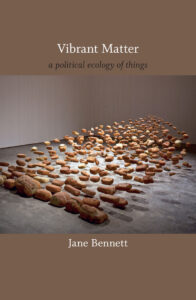I found this week’s topic really interesting as it was something I wasn’t entirely familiar with or ever properly understood. The lecture and the seminar truly opened my eyes to this rather complex concept. Jane Bennett explains it best in the book ”Vibrant Matter”, which encapsulates a deep dive into the idea of vital materialism. Basically, the point of the book is to prove that inanimate things around us, such as objects all have a life of their own, even a kind of will. When we develop an emotional attachment to a certain object, we give it life and charge it with memories. For example, when we look at the way little kids treat their toys, it is almost as if the toys are alive and have moods and personalities. Another great example that I remember from the seminar, are organs. Technically we do not perceive them as alive beings, but together they help humans be alive. Therefore, the concept of materialism is a thought provoking one and it left me with a different perspective on the world around me and the objects I interact with on a daily basis. As a future interior designer or architect, working with objects and inanimate elements will represent 90 percent of my time, thus, learning to properly understand and take care of them is quintessential.





